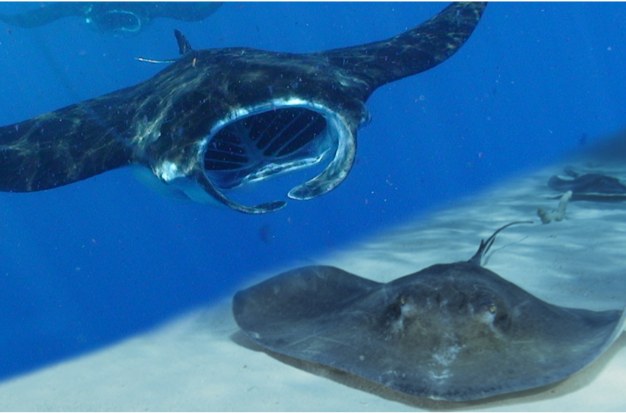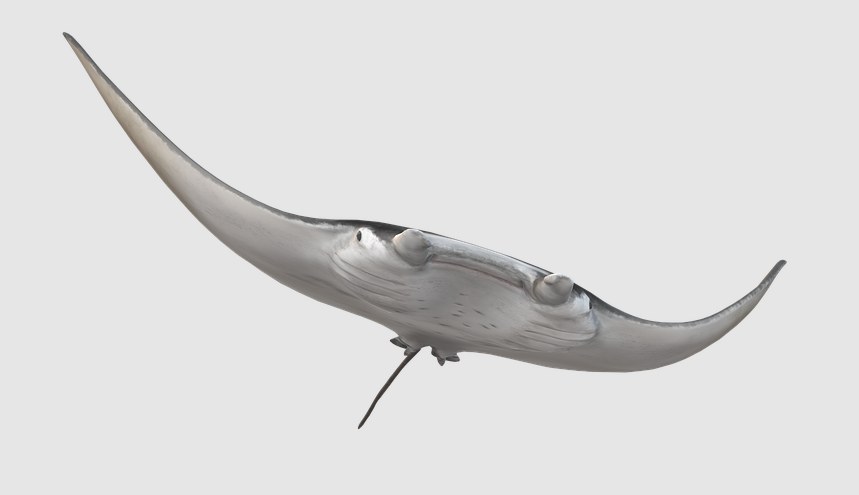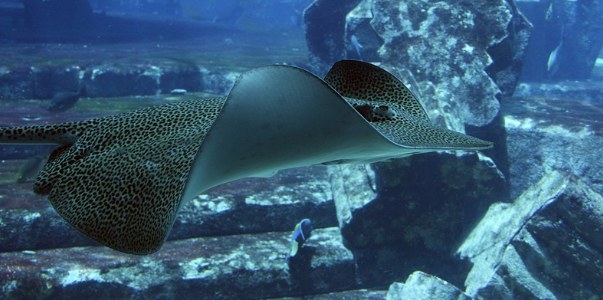
You might be surprised to learn that manta rays and stingrays are actually very different even though they have similar appearances. Despite belonging to the same family of fish as sharks, they are very different from one another. It’s simple to understand the confusion because both fish are flat and have wings that allow them to float through the water.
In this piece, the similarities and differences between manta rays and stingrays will be discussed. Furthermore, we’ll discuss which of the two is generally safe and which one can be dangerous.
Is There A Difference Between A Manta Ray And A Stingray?
They are not related at all; they belong to entirely different species. Both prefer warm, tropical waters, but mantas are larger and reside on the ocean floor, whereas stingrays are smaller and prefer shallower waters.
About Manta Rays

Giant and reef manta rays are the two types of mantas. Most often, when people mention manta rays, they mean the enormous ones. Due to the fact that they let divers and snorkelers swim with them, these gentle giants of the ocean have become a well-liked tourist attraction.
According to the endangered species act, manta rays are classified as threatened.
- Size: The largest ray species is the giant manta, which can grow to a length of 23 feet, weigh 5300 pounds, and have a wing span of up to 29 feet!
- Range: Manta rays are migratory and exist all over the world. Though they prefer warmer waters, they can survive in waters as cold as 65–70 F.
- Diet: Manta rays are filter feeders that almost exclusively consume plankton, though they occasionally eat small fish and crustaceans.
- Lifespan: Manta rays have a lifespan of roughly 40 years.
Manta Rays: Are They Hazardous?
Except for plankton, manta rays pose no threat to anyone. There may be conflicting information about manta rays having teeth, but the truth is that they do, despite never using them.
In places like Hawaii, you can even snorkel or dive with mantas—I’ve done both! There were times when one was only a few inches away from my face, which was an amazing experience.
I can say with certainty from experience that manta rays are not dangerous and, if it’s possible, even friendly. They constantly swim in search of food, completely unconcerned by humans trying to capture images of these incredible creatures.
About Stingrays

Although much smaller than their manta cousins, stingrays are cartilaginous fish like sharks. The 220 species of stingrays that have been identified include both freshwater and saltwater varieties. A large number of them are also listed as endangered or threatened. In shallow water, stingrays like to bury themselves in the sand as they patiently await their next meal.
- Size: Some species have wingspans of up to 16.5 feet and can weigh up to 1,320 pounds, while others only have wingspans of 10 inches.
- Range: Primarily in shallow waters, they are present in all tropical and subtropical oceans.
- Diet: The majority of stingrays eat small fish, crustaceans, and mollusks.
- Lifespan: In the wild, sting rays can live for 15 to 25 years.
Are Stingrays Safe?
Experts believe that stingrays are timid and docile animals that only attack when threatened or cornered. However, they have dangerous venom embedded in the spines of their tails. Although it is extremely unlikely, if you are allergic to the venom, you could fatally be affected by it.
Differences Of Manta Ray And Stingray
1. Barbs Are Not Found In Manta Rays.
These animals’ tails are the main distinction between them. Even though they may appear to be similar to a casual observer, they are very different.
The barb might be poisonous and have serrated edges depending on the kind of stingray. The venom in a stingray’s barb is lethal enough to kill humans.
Stingrays don’t hunt with their barbs, and that is important to know. Instead, when predators approach, they defend themselves by using barbs.
Manta rays have long tails like stingrays. But they lack barbs. This means that neither you nor anyone else will be stung by a manta ray.
You might be curious about how they defend themselves. Manta rays use their size and speed to flee dangerous predators. Manta rays do not have many natural enemies, though.
2. They Eat Distinct Dietary Types.
Manta rays filter the water’s zooplankton using their gill rakers, which are located beneath their bodies. They do not eat fish; in spite of their enormous size, they only eat tiny organisms.
Manta rays move through the water with the appearance of flying. Their graceful pectoral fins help them as they float through the water.
Stingrays eat much larger animals as food. Clams, seaworms, tiny fish, shrimp, and squid have all been observed being consumed by them.
Stingrays use the sand on the ocean floor to hide while they hunt. They conceal themselves from their prey.
They can eat prey they find on the ocean floor because they have their mouths at the bottom of their bodies.
3. A Electromagnetic Sense Is Present In Stingrays.
Like sharks, stingrays use electricity to find their prey. A stingray’s electromagnetic sense can detect any small animal. On the ocean floor, they are experts at detecting minute electrical pulses in the water.
Shrimp and small fish, for example, emit a tiny electrical current whenever they move. To locate prey, stingrays use this current.
They don’t need to use their eyes, ears, or nose, which is their sense’s most amazing characteristic. As a result, they are able to detect electrical currents in their prey that are buried in the sand.
4. Both Marine And Freshwater Environments Are Home To Stingrays.
Stingrays and manta rays are found in warm ocean waters all over the world. The only animals that can live in freshwater are stingrays.
Living in the Amazon is the freshwater stingray. It expands to a width of about 18 inches.
Don’t be fooled by their diminutive size. More human casualties are caused by them than by any other Amazonian species. It’s due to their deadly barbs.
5. Stingrays Are More Aggressive While Manta Rays Are Larger And Smarter.
The largest manta ray species is the Giant Oceanic Manta Ray. Their wingspan, which can reach 29 feet long, is large. But manta rays are notable for more than just that.
Manta rays have huge brains. They are a group of jovial and inquisitive geniuses. Manta rays have enormous brains, just like elephants do.
They are one of just three types of animals that are capable of having self-awareness. The manta ray’s capacity for self-awareness is currently being researched by scientists. If confirmed, they’ll join dolphins and apes as creatures capable of developing self-awareness.
Stingrays are more aggressive than manta rays, despite being bigger. Shuffle your feet on warm beaches because of this.
The shallow water may be home to many stingrays. Stingrays use their barbs as a form of defense if they are stepped on. They pose a danger whenever they are nearby as a result.
The giant freshwater stingray is the only stingray species that can grow as large as a manta ray.
In the Greater Mekong, there is a huge freshwater stingray that lives. These stingrays can get as big as 16 feet across and weigh 1,300 pounds!
Conclusion
As we compared the attributes of manta rays and sharks, Stingray, there are many differences between these two marine animals that we have seen.
The most obvious characteristics include an appearance in terms of size, shape, coloration, typical habitat, and feeding habits.
But stingrays and manta rays are related, and they have a lot in common, like giving birth to live young and having flat bodies.
Man-made activities like unrestricted fishing put stingrays and manta rays in danger.
If you are fortunate enough to see one of these amazing wild animals in the wild, take advantage of the opportunity and try to do what you can to protect it.






